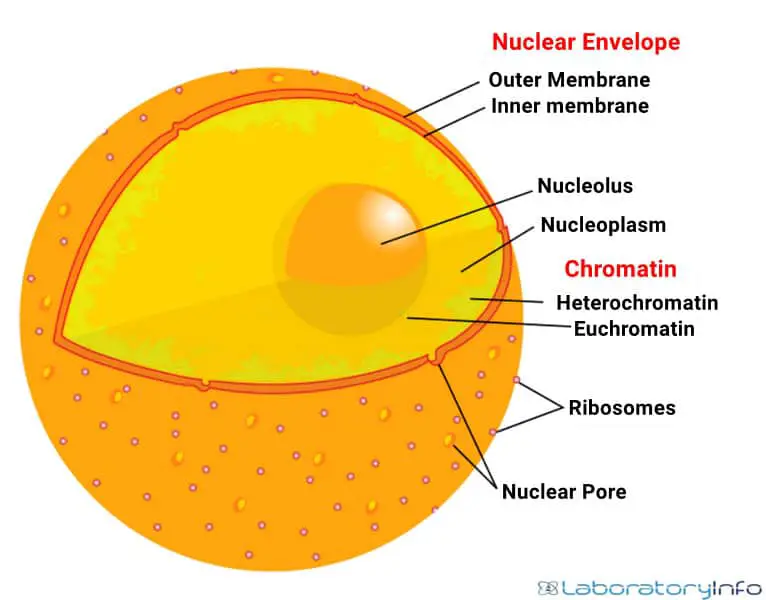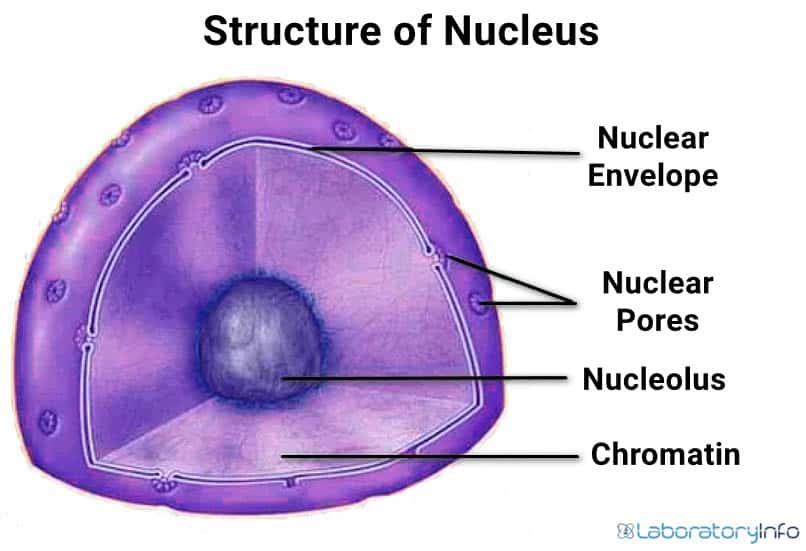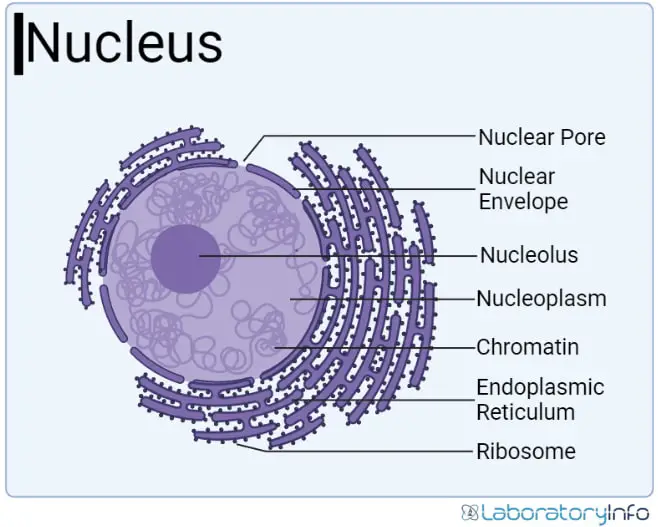Introduction
The word Nucleus is a common term in biology. The Nucleus is an integral component of every cell. The Nucleus is a special type of membrane-bounded structure found in cells. The Nucleus contains a genetic material made up of eukaryotic organisms. In a eukaryotic cell, the Nucleus is present at the center and is the most prominent organelle in the cell, accounting for 10% of cell volume.
For a better understanding of the cell, have a look at its picture

source: toppr.com
Definition of Nucleus
A nucleus is defined as a double-membered eukaryotic cell organelle that consists of genetic material (that contains information related to its growth and reproduction) and it is sometimes referred to as a “central unit”. The Nucleus maintains the integrity of the cell through transcription facilities. The Nucleus is the largest organelle in the cell, and it is one of the organelles that can be identified easily under the microscope.
The cell is a functional component and fundamental organization in living things. The cell is the simplest form of construct that contains and defines all the properties assigned to live.
Structure and Parts of Nucleus
The Nucleus is at the center of the cell. The Nucleus contains the genetic material present in the cell. The Nucleus contains the different structural elements that facilitate the functioning of the cell. Here are all the elements in the Nucleus:

Source: justscroll.com
Nucleus DNA
- The nucleus DNA includes significant proportions of the genome in a cell (it’s a tiny part that comes from the extranuclear DNA commonly found in the chloroplasts and mitochondria).
- The DNA that is present outside the Nucleus is called extra-nucleus DNA. Extra Nucleus DNA is similar to cpDNA and is mostly found in mitochondria. At the same time, the other element, i.e., chloroplasts, is presented in multiple places with multiple copies of elements as there are multiple mitochondria and multiple chloroplasts. Still, there is only one Nucleus in a cell.
- The nucleus DNA is grouped into a structure shaped like chromatic through histones, except cpDNA and mtDNA.
- It has thousands of copies in cpDNA and mtDNA.
Chromatin/ chromosomes
- The nucleic acid (RNA and DNA) and proteins (histones) refer to chromatin.
- In cell division, the chromatin is grouped to create a chromosome.
- The main role of the chromosomes or chromatin is to pack the DNA into a smaller size so that it fits into the cell.
- The nucleosome is the basic structural unit of chromatin.
- Heterochromatin and euchromatin are the two main forms of chromatin.
- The euchromatin comes in a loose structure. It allows replication and transcription. On the other side, heterochromatin is less active, condensed, and consequential.
- Each of the nucleosomes includes a segment of DNA wrapped around the protein cores of histone.
Nuclear Bodies
- A nucleus inside the Nucleus is defined as a non-membrane proteinaceous substance in the body. The nucleolus is one of the Nucleus’s popular and important nuclear body parts.
- Other names for nuclear bodies are nuclear dots or nuclear domains. They are structures of membranelles found in the Nucleus in eukaryotic cells.
- The nuclear bodies include the nucleolus promyelocytic leukemia protein.
Nuclear Membrane
- Its primary function is to separate the Nucleus elements. The membrane’s outer layer contains endoplasmic reticulum.
- The endoplasmic reticulum and nuclear envelope are connected so that the inner part of the nuclear envelope continues the connection with the Endoplasmic reticulum’s lumen.
- In between the two layers of the nuclear layer, there is a liquid-filled or perinuclear space.
- The Nucleus enters the cytoplasm through nuclear pores.
- The nuclear membrane consists of lipids and proteins.
Nucleolus
- These are denser, smaller, and round in shape. These are found in Nucleus.
- The Nucleus contains one nucleolus.
- The nucleolus is usually placed at a particular area of the particle chromosome. While the region of this particular chromosome is where it remains attached is known as the secondary constriction.
Nucleoplasm
- The Nucleoplasm is a kind of protoplasm. Moreover, it consists of enzymes, dissolved salts, and organic molecules.
- The nucleoplasm also acts as a cushion in order to protect the chromosomes and nucleolus.
- Additionally, it also helps in maintaining its shape.
Functions of Nucleus
The Nucleus of the cell controls the organism’s characteristics and properties. This organelle also ensures the growth of protein, growth, division of cell protein, and differentiation in the cell. The Nucleus carries all the essential functions in the cell. Here are the following of them listed.
- The Nucleus is known for its storage functions as it stores RNA and proteins in Nucleus.
- Chromatin acts as a storage option for storing the genes in thin and long DNA strands and other materials.
- The Nucleus also functions as an exchanger of the hereditary molecules DNA and RNA between the cell nucleus cell and the rest of the cell particles.
- The cell functions nucleus also performs the production of the ribosomes in the nucleolus.
- The Nucleus also functions as a transcription site where messenger RNA is developed to synthesize the protein.
- During cell division, the chromatins are lined into the Nucleus chromosomes.
- The Nucleus also helps function in the growth and development of the ribosomes in the Nucleus.
- In addition, the nucleus serves as the selective transport for the energy molecules and regulatory factors through the nuclear pores.
- It controls all the biological activities that happen in the cells.

Nucleus Types
There are different types of Nuclei differentiated based on their cell’s presence and absence. Here are those mentioned:
Unicleate cell
This cell is also known as a monokaryotic cell. It is found in plant cells and contains only one nucleus.
Enucleate cell
Those cells which don’t contain the Nucleus are called enucleate cells. Some living creatures like mature sieve tubes and mature mammals lack nuclei.
Bi-nucleate cell
This type of cell is also known as the dikaryotic cell. This cell contains two nuclei. A common example includes paramecium (having micronucleus and mega), liver cells, Balantidium, and bone marrow cells.
Multinucleate cell
This cell is also known as the polynucleated cell, containing more than two nuclei. Common examples containing these types of cells are latex vessels and plants latex cells.
This is all about the Nucleus, its functions of the Nucleus, structure the Nucleus, types of Nuclei, and its distribution.
